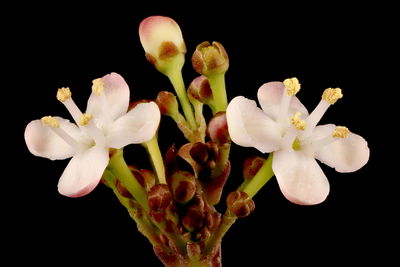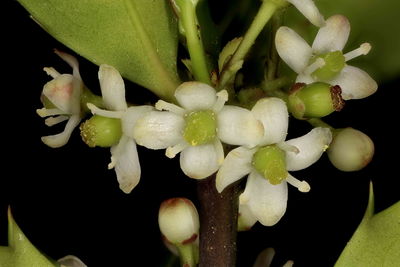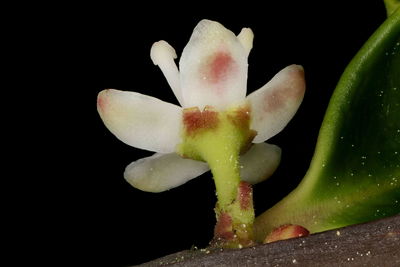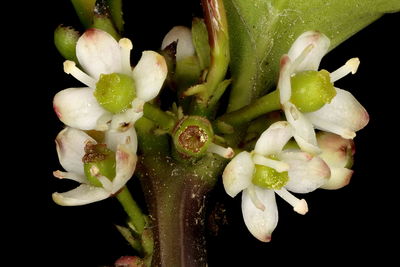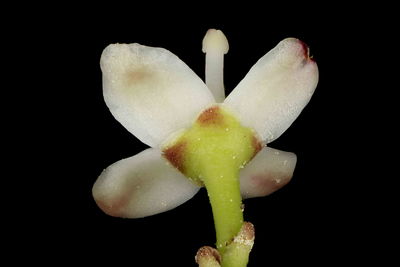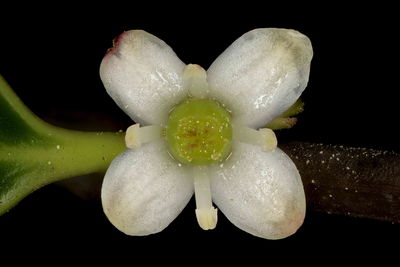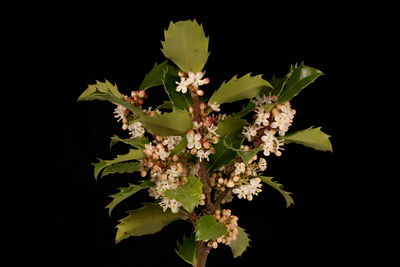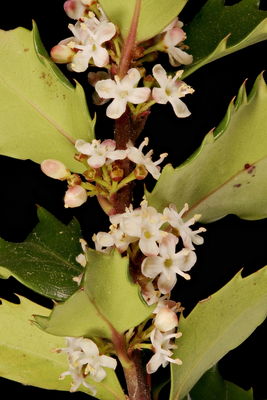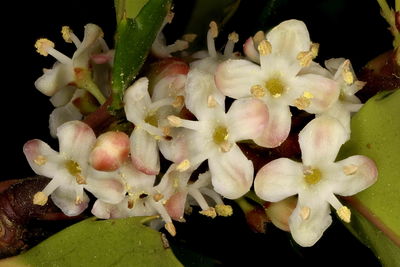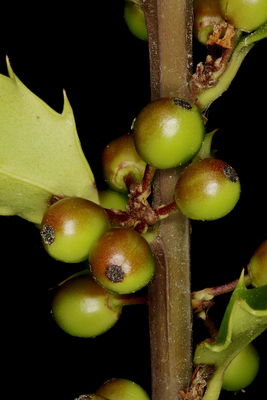Geography and distribution
Ilex aquifolium is native to West Asia, North Africa, and South and West Europe, including all areas of Britain except northern Scotland, the Outer Hebrides and the Orkney and Shetland Islands. It is commonly found as an understorey tree or shrub in oak and beech woods.
Common holly in Britain
True holly woods, of the kind found in Epping Forest, the Welsh Marches and as groups of huge unpollarded trees in Cumbria, are relatively unusual. Holly sometimes forms large circular groves of trees in the wild, such as in the New Forest in Hampshire, but otherwise occurs among mixed woodland and in hedgerows.
It has been reported that the last remaining commercial holly farmer in Britain (in Norfolk) retired in 2000, but there is still an annual pre-Christmas market for holly and mistletoe at Tenbury Wells in Worcestershire.
Description
Ilex aquifolium is a large evergreen shrub or pyramidal tree growing up to 25 m tall, with glossy, dark green (though occasionally variegated), wavy-edged, spiny leaves 3-10 cm long and 2-5 cm wide. On higher branches (where grazing animals pose less of a threat) the leaves have virtually no spines. The small, fragrant white flowers each have four petals and are insect-pollinated. The fruits are globe-shaped, 7-10 mm in diameter and are normally red, but can occasionally be yellow. They each contain four seeds, are usually borne in clusters, and are eaten by birds which disperse the seeds.
A true berry?
The fruit of common holly is technically a drupe, and not a berry. A true berry, such as a gooseberry, consists of several seeds enclosed within the soft flesh formed from the ovary wall. In drupes, such as holly fruits and plums, the seeds are enclosed in a hard case surrounded by soft flesh.
Uses of common holly
Ilex aquifolium has been planted extensively in parks, gardens and hedges, particularly for its winter berries. Freshly cut holly burns fiercely and makes excellent firewood. Its white, fine-grained, hard wood is used for decorative carving and was formerly used for mathematical instruments and light machinery components; it has even been dyed black and used as a substitute for ebony piano keys. Slender, pliable branches of coppiced holly were formerly used in great quantities for horse whips. In the Forest of Bere (Hampshire) it used to be held that milk drunk from a holly-wood bowl would cure a child of whooping-cough.
Holly's dense foliage of spiky protective leaves, and its easily trimmed shape, suit it perfectly to hedging. In many parts of Britain it was once considered bad luck to cut down a holly tree as its evergreen leaves were considered a sign of eternal life and supernatural powers. Some still hold to these beliefs and many holly trees are found in the midst of hedges where they serve as useful landmarks for local people. Oils found in the thick skin of holly leaves produce a flammable vapour when heated, which causes them to ignite easily. Unfortunately this means that holly can be easily destroyed in forest fires.
The distinctive berries provide a feast for birds (such as blackbirds and thrushes) and other animals (such as wood mice) in winter when there is often little other food available. Although hard and extremely bitter in the autumn, the berries become softer and more palatable to wildlife after being frozen (although they are mildly toxic to humans). Holly leaves provide food for insects including the holly leaf miner and the holly blue butterfly. They have also been used as a winter feed for sheep, sometimes processed in a mill to make them more palatable, and the dense vegetation provides good shelter for livestock.
Common holly and Christmas
In Britain and many other western cultures, holly is closely associated with Christmas. It makes an ideal festive decoration, with its bright red berries set against dark green, glossy leaves. The tradition of holly decoration predates Christianity and probably began with the early pagans of Europe, who brought holly inside in the winter to keep evil spirits away. The Romans sent holly branches with presents during the December festival of Saturnalia.
These practices were later adopted and adapted into Christian tradition, building on the symbolism of the crown of thorns and the red berries representing drops of Christ's blood. However, traditional belief in its powers to avert witchcraft and even to defend a house from lightning continued. In some parts of Scotland holly branches used to be piled up against the doors inside houses to protect the inhabitants. Various beliefs linger around the use of holly at Christmas: some believe that keeping holly decorations indoors after Twelfth Night brings bad luck on the household; others contend that they should be put aside until Shrove Tuesday for cooking pancakes.
The holly and the ivy,When they are both full grown.Of all the trees that are in the wood,The holly bears the crown.
Millennium Seed Bank: Saving seeds
The Millennium Seed Bank Partnership aims to save plant life worldwide, focusing on plants under threat and those of most use in the future. Seeds are dried, packaged and stored at a sub-zero temperature in our seed bank vault.
There are five collections of Ilex aquifolium seed held in Kew's Millennium Seed Bank based at Wakehurst in West Sussex.
See Kew's Seed Information Database for further information on the seeds of this species
Cultivation
Ilex aquifolium has been cultivated since ancient times and numerous cultivars and hybrids with other species (much for sale is Ilex x altaclerensis ) with green or variegated leaves are available. Hollies grow best in light humus loam with a pH of 6.0. A well-drained soil is required. Plants should be watered thoroughly after planting, and then weekly for the first year if there has not been sufficient rainfall. Proper watering is essential for the establishment of new plantings. A slow-release fertiliser should be used for several years until the holly is firmly established.
Common holly at Kew
Many cultivars of Ilex aquifolium , together with other species and cultivars of Ilex , can be seen growing along Holly Walk. The Holly Walk is towards the south end of the Gardens (near the Rhizotron and Xstrata Treetop Walkway) and runs for two-thirds of a mile behind the Evolution House to the rose family collections, ending at the Cedar Vista.
The Holly Walk is one of the Gardens' historic features, and is planted along what used to be Love Lane, which made up part of the main public right of way from Kew to Richmond. The holly plants along the walk represent one of the largest, most comprehensive collections of mature hollies in cultivation in the world. The collection is well-documented and has been worked on by Kew taxonomists since 1976.
Preserved specimens of Ilex aquifolium are held in the Herbarium and Economic Botany Collection: two behind-the-scenes areas of Kew. Details of some of these specimens can be seen in the online Herbarium Catalogue.

























